
St Mark, EASTON
Bristol
(1848 -1984)
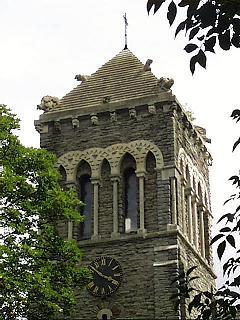 |
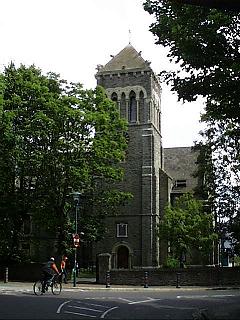 |
Known to many people who travel by train and pass through Stapleton Road Station in Bristol as that odd structure by the track. the railway is raised on an embankment and all one sees is the strange top stage of the tower. The railway added to the prosperity of the church, and it was not unknown for people changing trains here to nip off the platforms and attend a service.
The church was designed by Charles Dyer (1794-1848) in an exuberant Norman style. Although parts were obviously C19, such was the skill of the design that you questioned whether the church was an ancient one. Dyer died before the church was completed and S.B.Gabriel supervised the work to completion. the church was consecrated on 18th May 1848. It consists of a five-bayed nave, lower apsidal vaulted chancel and a north porch tower. The top stage of the tower bursts into decoration with interlaced arches and colonettes, and the whole is finished by a stone pyramid alive with animals crawling down the ridges and a tall iron cross. The Norman work was taken to the extremes, even the gates are in this style!
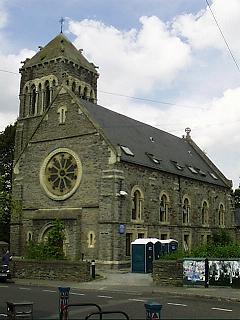 |
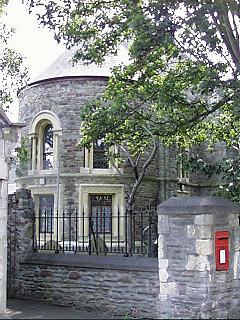 |
Dry Rot was discovered in the nave roof in 1981, and the costs of repairs proved beyond the means of the parish. The parishes of St Thomas (closed 1976) and St Anne Greenbank, both daughter churches of St Mark, were joined with St Mark and the church became redundant. The final service, Holy Communion, was held on 18th May 1984, 136 years after the consecration of the church. The church was then purchased and converted into a supported housing scheme. This has necessitated insertion of additional windows below the converted Norman lights and above in the roof space. The west front with its huge wheel window above the west portal remains largely unaltered along with the tower.
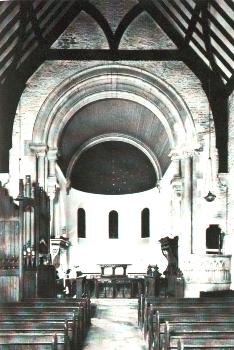 |
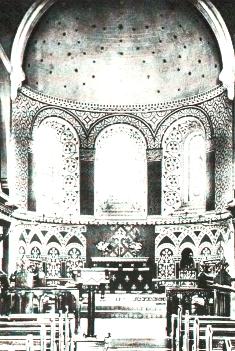 |
The interior is now lost forever. It was simple and in the latter years much of the decoration had been toned dow. Compare the picture on the left with the earlier one of the sanctuary on the right. Even the frescoes had intersecting arches, a motif of course taken fron the chapter house of Bristol Cathedral. It seems not an inch of wall or window splay was left unpainted. What did survive were the painted stars in the apse vault although the colours seem like they were reversed when redone. Note also the noble chancel arch, and the pulpit in matching style, again with interlaced arches. The latter was entered via the small south-east vestry. The organ was unhappily sited in the north-east corner of the nave. It used to stand on a gallery under the tower.
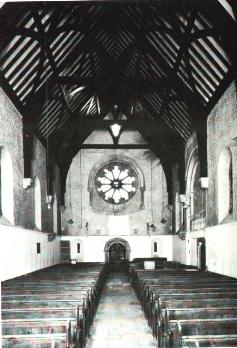
Looking west from the chancel, the simple effective design can be appreciated and it could have been original Norman work retooled. The walls were plastered below the windows but rough exposed stone in the upper walls added to this sense of being original C12 work. As a child aged 10, exploring architecture for the first time I believed it was. To the right in this photograph you can see the blocked tower arch where the organ used to be situated. The font by the doorway from the tower was also decorated with Norman interlaced arches.
There is an excellent booklet by Lionel W Ellery "The St Mark (Lower Easton) Story" from which these interior pictures have been scanned. Sold in aid of the church funds of St Anne Greenbank, I sadly notice, to which many fittings from St Mark were transferred
Almost one year to the day I created this page I received a lengthy informative E-mail from Rev. David Cawley, vicar of St Anne Greenbank 1983-95, and who would have loved to have preserved the church and resisted many schemes for the site until the present housing scheme came about. He writes:-
" The decoration was on the chancel and sanctuary walls only and was carried out in either 1887 or 1897 to celebrate one of Queen Victoria's jubilees (the clock in the tower likewise, 1897). I have a photo pre-1887 when only the exposed stonework was decorated. The decorations were removed, and some of the stained glass "lightened" following the 1948 centenary of the church. The nave was always plain, but the tower arch was open until the organ was rebuilt in 1898 at the top of the nave. The same organ was again rebuilt to its original specification in St Anne's in 1984.
At St Anne's also you will find the Altar Ornaments and Plate, memorial tablets, the original bell of 1853 (the earliest one in Bristol cast by the Bristol founders Llewellins & James) as well as other smaller artefacts. Not the font though; we actually considered it, but it really was too big. Instead we had the rather nice octagonal font from Hallen (South Gloucestershire). The St Mark's font, given by Dr Woodford himself, was given to the great public school chapel of St Chad, Denstone, Staffs, where it may be seen in all its glory. The stained glass went to the Ely Stained Glass Museum at Ely Cathedral - appropriately, as Dr Woodford became Bishop of Ely 1873-85, and would have recognized most of the glass. "
Page updated 10th March 2002